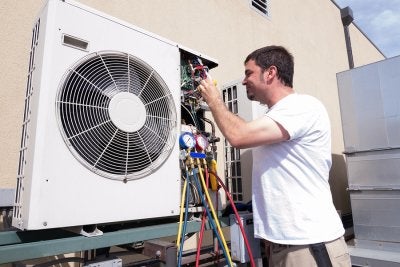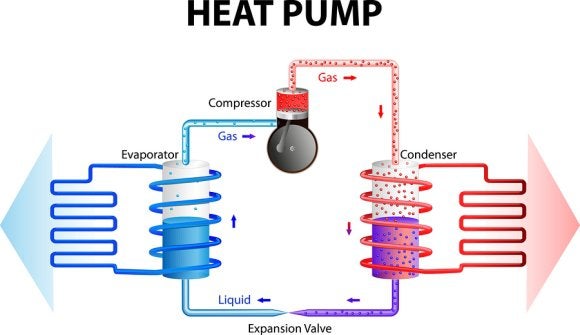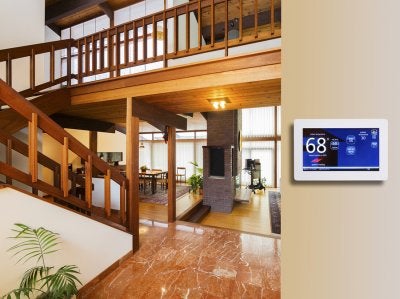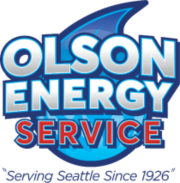-
The Olson Energy Service Story
Olson Energy Service specializes in electrical, water heater, air conditioner, air duct cleaning, boiler, heat pump, and furnace services in Seattle. Family-owned and operated, Olson Energy Service has provided the Greater Seattle Area with decades of first-rate, experienced, and reliable service.
Founded by Garnett Olson in 1926, Olson Energy Service began as Olson Fuel Company, which sold coal and firewood to homes and businesses. By the 1930s, heating fuel preferences shifted towards oil, and the company expanded to include this service. Generations of Olsons have worked for Olson Fuel Company, which became Olson Energy Service in the early 1990s as its range of services grew.
Today, Olson Energy Service boasts numerous affiliations and awards and is among the premier HVAC contractors for Seattle. Our experienced staff continues to provide exceptional, professional, and quality service throughout the Greater Seattle Area and looks forward to helping you with your heating and cooling needs.
““
-
What is a Mini-Split Air Conditioner?
Are you considering your different options for air conditioning near Seattle? Mini-split systems offer heating and cooling solutions for areas that lack central air conditioners or heating systems.
Design
Mini-split air conditioners are ductless units that are used to cool a room or area of a building. These units are similar to central systems in that they have both an indoor and outdoor component. Mini-splits consist of an outdoor condenser/compressor and an indoor air-handling unit.
Uses
 While there are numerous potential applications for these air conditioners, most often they are installed as retrofit add-ons for buildings that lack a ducted heating system. Examples can include homes that are heated using radiant panels, space heaters, or hot water heat. Mini-split air conditioners are also an excellent cooling solution for small apartments and room additions where it may not be feasible to install ductwork.
While there are numerous potential applications for these air conditioners, most often they are installed as retrofit add-ons for buildings that lack a ducted heating system. Examples can include homes that are heated using radiant panels, space heaters, or hot water heat. Mini-split air conditioners are also an excellent cooling solution for small apartments and room additions where it may not be feasible to install ductwork.Advantages
Due to their small size and the flexibility of their installation, mini-split air conditioners can be used to cool a single area or room. Additionally, many models can have up to 4 indoor handling units connected to a single outdoor condenser/compressor. Because each indoor unit has an individual thermostat, you can save money by cooling only the areas that you wish. Mini-splits also tend to be easier to install than other cooling systems. Most styles require only a 3-inch-wide hole through the wall to connect the indoor and outdoor components, and your indoor air-handling units can be as far as 50 feet from the outdoor apparatus. This allows home and business owners to install the outside section in an inconspicuous place, if necessary.
Disadvantages
The primary drawback that you will face if you opt for a mini-split air conditioner is the cost. These systems will require more investment per ton of cooling capacity when compared to central units, assuming there is already ductwork present, and can cost significantly more than a window cooling unit. Additionally, mini-splits can be more conspicuous than central air vents, but they are generally less obtrusive than window air conditioners.
““
-
Get the Most Out of Your Air Conditioner
A lack of proper maintenance is the primary reason that HVAC units fail. If your air conditioning near Seattle hasn’t been inspected for over a year, it may not be functioning at maximum efficiency. Watch this video for tips on getting the most out of your air conditioner.
If your A/C sounds noisy, keeps turning on and off, or seems to be running all day, then you may benefit by scheduling air conditioner maintenance. Also, a rise in the cost of your monthly energy bill or a higher humidity level in your home are both indicators that the unit may be functioning poorly and can benefit from a tune-up. Your air conditioner loses an estimated 5% of its efficiency each year that it isn’t inspected and cleaned.
-
Choosing the Right Size Air Conditioner
If you’re in the market for a new air conditioner and live in the Seattle area, selecting the right sized unit for your space is essential. When an HVAC unit’s cooling capacity is too small, it will fail to keep your home at a comfortable temperature. When your A/C is too big for your home, it will use more electricity than is necessary and will make your home’s interior unpleasantly humid. Figuring out the right size air conditioner for your needs is vital for maximizing the unit’s efficiency and performance.
Measure your home’s square footage.
 Determining the size air conditioner that you need will require some measurements and a bit of math. First, measure the square footage of each of the rooms that you intend to cool. Use a tape measure to learn the length and width of one room, and write these measurements down. Next, multiply these two numbers to figure out the square footage. Complete this process for each room of the house, writing down the measurements and totals as you work. Be sure to include only areas that your central ducts reach, excluding basements, garages, and attics.
Determining the size air conditioner that you need will require some measurements and a bit of math. First, measure the square footage of each of the rooms that you intend to cool. Use a tape measure to learn the length and width of one room, and write these measurements down. Next, multiply these two numbers to figure out the square footage. Complete this process for each room of the house, writing down the measurements and totals as you work. Be sure to include only areas that your central ducts reach, excluding basements, garages, and attics.Determine your cooling capacity needs.
The next step toward finding out what size air conditioner you need is to use your measurements to determine the cooling capacity required for your home. The cooling capacity of central air systems and room air conditioners is measured using British Thermal Units (BTUs) per hour. The United States Department of Energy’s Energy Star website provides guidelines for determining the BTUs needed for your home or room’s square footage .
Consider your home’s additional factors.
Choosing the right size air conditioner can depend on a few things besides your home’s square footage. If your house receives significant sunlight or has many windows, it may need more cooling capacity than one that is shaded or allows less sunlight into the interior. Your home’s insulation will also contribute to its need for cooling capacity. Experts recommend having multiple HVAC contractors perform an estimate on your home before you make a decision about purchasing your new air conditioner.
-
Easy Ways to Boost Your Air Conditioner Efficiency
Many people are looking to save on their energy bills by making their air conditioning near Seattle as efficient as possible. Fortunately, there are a few things you can do to promote the efficiency of your air conditioner. Read on to learn about some easy ways to help your HVAC system save energy .
Inspect Your Air Filters
A clogged filter can make your air conditioning system work on overdrive. Thus, it’s important to check and replace your filters regularly to increase the lifespan of your HVAC system, cut costs on your energy bills, and reduce the amount of dust and allergens circulating through your home. Check your filters monthly and consider calling an HVAC professional if you need help replacing them.
Consider the Location of Your Unit and Thermostat
 In order to keep your air conditioning unit working efficiently, avoid installing your unit and thermostat in an area that gets a lot of sun. Placing your unit in a shaded location will make cooling the surrounding air easier. In addition, keep your unit’s thermostat away from heat-producing objects, such as lamps, television sets, computers, and other electronics. Your air conditioner will run longer than it needs to if it senses these nearby sources of heat.
In order to keep your air conditioning unit working efficiently, avoid installing your unit and thermostat in an area that gets a lot of sun. Placing your unit in a shaded location will make cooling the surrounding air easier. In addition, keep your unit’s thermostat away from heat-producing objects, such as lamps, television sets, computers, and other electronics. Your air conditioner will run longer than it needs to if it senses these nearby sources of heat.Adjust the Dial
Keep the thermostat at 78 degrees or higher to significantly reduce your energy consumption. It’s especially important to turn the dial before you leave the house so that your air conditioning unit won’t be running while your home is unoccupied. If you frequently forget to adjust the temperature before heading out, you might want to consider installing a programmable “smart thermostat” or timer so that this important task is completed automatically.
Weatherize Your Home
Prevent cool air from leaking out of your home by caulking and weather-stripping problem areas. You may also want to insulate your air conditioning ducts to prevent energy losses if they run through unconditioned areas such as your attic or crawlspace. Finally, applying window film to your windows can also help reduce the energy required to maintain a cool temperature in your home.
-
Highlighting the Advantages of Heat Pumps
Are you considering installing a heat pump near Seattle ? A heat pump can help keep your home at a comfortable temperature all year round by warming your house in the winter and cooling it in the summer. Plus, heat pumps require less energy than other types of heating and cooling systems, meaning a heat pump can help you cut down on your energy expenses.
Heat pumps work through the use of a compressor to move heat from one area to another. In the winter, a heat pump takes heat from the outside air and pumps it into your home. In the summer, it acts as an air conditioning system by reversing this cycle.
In addition to their versatility, heat pumps have numerous other advantages. First of all, they are easier to maintain and have a longer lifespan than conventional heating and cooling systems. In addition, they transfer heat rather than generate it, reducing your energy consumption and thus your carbon footprint. Finally, heat pumps also act as dehumidifiers, making your home more comfortable in the summer without increasing your electricity bills.

-
Advantages of Having an AC in Seattle
While Seattle is known for being a damp, rainy place, the city has recently experienced hot, dry summers that are only getting warmer. July of 2015 was the hottest month on record in Seattle’s history, with temperatures topping out at 95 degrees Fahrenheit. Instead of suffering through another hot summer, consider getting air conditioning so that you can be comfortable in your own home. Air conditioners give you the option to only use them when you need to, and not when you don’t. Your home’s security can also benefit, as you won’t have to have open windows for air circulation. Check out this infographic to learn more about why it’s a good idea to get an air conditioner in Seattle , and to learn about a few of your options.

-
Understanding the Basics About Tankless Water Heaters
If you have a tankless water heater in Seattle, you know that this type of hot water heater offers numerous benefits and can even reduce your electricity expenditures. Thanks to its on-demand heating capabilities, you won’t need to maintain the temperature of a large boiler using a tankless water heater.
Watch this video to learn more about how a tankless water heater works. A tankless water heater won’t run until there’s a demand for hot water heater in your house, such as when you turn on the hot water tap in the shower. This type of water heater can be up to 30% more efficient than a traditional tank type water heating system. If you’re looking for instantaneous savings, a tankless water heater may be the right choice for your home’s hot water needs.
““
-
What Is a Ductless Air Conditioner?
Are you considering installing ductless air conditioning near Seattle ? Ductless air conditioning is a great choice for residential or commercial buildings that have non-ducted heating systems or lack space for adding ductwork. Keep reading to get the scoop on what a ductless air conditioner can do for you.
How It Works
A ductless mini-split air conditioner is composed of two main elements. One, the compressor and condenser, is installed outdoors. The other is an indoor unit that diffuses air throughout the room. The two components are connected by a conduit, which contains the multiple cables and tubing that the system requires. Several indoor air handling units may simultaneously be connected to one outdoor unit. The result is that each indoor unit handles the temperature in its own “zone,” meaning that you can control the heating and cooling system in each room individually.
How It Looks
 Ductless mini-split systems are small and relatively easy to install. Installation of the conduit only requires a small hole in the wall about three inches in diameter, so it won’t require a major remodel. The indoor units of ductless air conditioners can be installed in the most convenient place for you, whether that’s hanging from the ceiling or the wall. And their sleek packaging blends seamlessly with your interior design. Placement of the outdoor unit is equally flexible; it can be installed at a distance of up to 50 feet from the indoor unit, meaning you can choose an inconspicuous location near your building.
Ductless mini-split systems are small and relatively easy to install. Installation of the conduit only requires a small hole in the wall about three inches in diameter, so it won’t require a major remodel. The indoor units of ductless air conditioners can be installed in the most convenient place for you, whether that’s hanging from the ceiling or the wall. And their sleek packaging blends seamlessly with your interior design. Placement of the outdoor unit is equally flexible; it can be installed at a distance of up to 50 feet from the indoor unit, meaning you can choose an inconspicuous location near your building.How It Saves Energy
Ductless mini-split systems can help you save on your energy expenses in a few ways. Most air conditioning systems that use ducts run through spaces that are not temperature controlled, such as the attic or crawlspace. This leads to energy losses and causes your cooling system to work extra hard. As mini-split systems don’t use ducts, they avoid this loss of energy. In addition, the flexibility of mini-split systems also helps you save energy and money by allowing you to cool only the spaces that are occupied at a given time.
-
Common Problems with Air Conditioning Units
Having trouble with your air conditioning in Seattle? One of the most frustrating things that can happen on a sweaty summer day is for your air conditioner to break for an unknown reason. Sometimes a simple fix can get your unit working properly, while other times it is necessary to call in the expertise of a professional. To learn more about some of the common problems that occur with air conditioning units, keep reading.
User Error
 That’s right—air conditioner units most commonly have issues because of improper use. When your air conditioner is on, make sure that all of the windows and outside doors in your house are closed. It’s also your responsibility to make sure that your air conditioning unit is properly maintained. That means keeping the air conditioning filters and coils clean to avoid premature compressor or fan failure. Finally, thoroughly read through user manual for some basic operating rules that can increase the lifetime of your air conditioning unit and prevent future problems from occurring.
That’s right—air conditioner units most commonly have issues because of improper use. When your air conditioner is on, make sure that all of the windows and outside doors in your house are closed. It’s also your responsibility to make sure that your air conditioning unit is properly maintained. That means keeping the air conditioning filters and coils clean to avoid premature compressor or fan failure. Finally, thoroughly read through user manual for some basic operating rules that can increase the lifetime of your air conditioning unit and prevent future problems from occurring.Refrigerant Leaks
If your unit is low on refrigerant, it is likely that you have a refrigerant leak. Refilling your unit’s refrigerant won’t solve this problem. You’ll need to call a professional technician to repair the leak and refill the repaired system with refrigerant. That’s because it’s important that the refrigerant charge precisely matches the manufacturer’s recommendations. If it is undercharged or overcharged, your air conditioning unit won’t work as it should.
Thermostat Sensor Issues
If your unit is behaving strangely by turning on and off at random periods, cycling constantly, or varying heating and cooling options, it’s likely that there is a problem with your thermostat sensor. The thermostat sensor is located behind the control panel and works to calculate the room’s air temperature. It can become dislodged, resulting in faulty temperature measurements. Check and make sure that the sensor is in place behind—but not touching—the evaporative coil. You can adjust the position of the sensor by moving the wire that holds it in place.
RECENT POSTS
categories
- Uncategorized
- Air Conditioner
- Fireplace Inserts
- Fireplace Insert Installation
- Air Conditioning Installations
- Air Conditioning Units
- Air Conditioner Maintenance
- HVAC Professionals
- Heat Pump Installation
- Heating and Cooling
- HVAC Unit
- Heat Pumps
- Furnace
- Furnace Service
- Tankless Water Heaters
- Water Heaters
- Energy Efficiency
- HVAC Contractors
- Olson Energy Service
- Mini-Split Systems
- Ductless Air Conditioner
- Residential Services
- Seasonal Boiler Maintenance
- HVAC Maintainance
